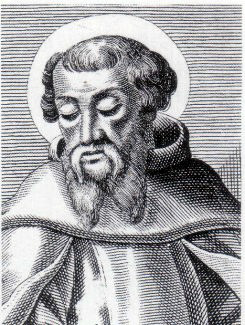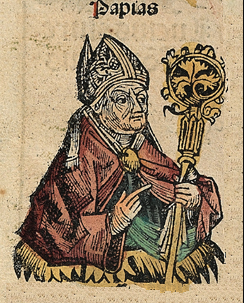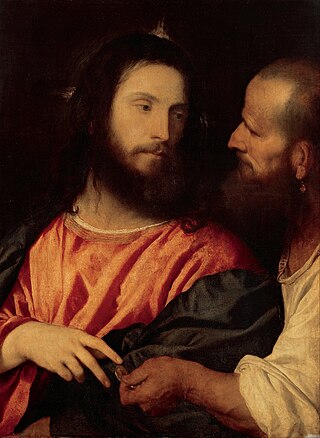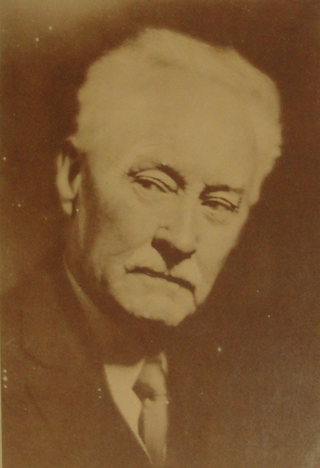Caesarian origin of Christianity
Francesco Carotta's theory runs contrary to all established theories on the historical Jesus. Carotta postulates that the historical person behind the Biblical figure Jesus Christ was not Jesus of Nazareth, but the Roman statesman Gaius Julius Caesar, from whose cult Christianity developed over the course of several generations.
Jesus was Caesar
The thesis of Carotta's book Jesus was Caesar is based on a comparison of the gospels, especially the earliest Gospel of Mark, with the ancient sources about the last years in the life of Caesar and his immediate legacy. Roman sources include Appian, Plutarch and Suetonius, who all relied to some extent on Caesar's contemporary Gaius Asinius Pollio and his lost Historiae, which according to Carotta might constitute the "Latin Ur-Gospel". This is augmented by comparisons from archaeology, numismatics, iconography, liturgy, and ritual traditions. Carotta argues that the multiple parallels he sees between the lives and cults of Caesar and Jesus can best be explained by his theory that Jesus Christ is based on the deified Julius Caesar, transformed and mirrored in the eastern Hellenistic and judaizing regions of the Roman Empire.
Within Carotta's theory the gospels are hypertexts after a diegetic transposition [7] of Latin and Greek Roman sources (hypotexts) on Caesar's life from the beginning of the Civil War, the crossing of the Rubicon, until his assassination, funeral and deification, conforming to Jesus' mission from the Jordan to his arrest, crucifixion and resurrection. Textually transformed from Rome to Jerusalem in Caesar's eastern veteran colonies, the Gospel narrative with its altered geography, dramatic structure, its characters and newly adopted cultural environment, would therefore have been written neither as a mimetic approximation of Caesarian attributes nor as a mythological amalgam, but as a directly dependent, albeit mutated rewriting (réécriture) of actual history.
He argues that, following this initial transposition, there was at first a redaction of the Caesarian Ur-Gospel inspired by Augustan history and theogony, whereby the later synoptic gospels by Matthew and Luke incorporated (among other pericopes) the Nativity of Jesus, originally transposed from the nativity of Augustus, and the resurrection narrative, according to the chronological-biographical structures in the historical account by Nicolaus of Damascus. Later generations produced more discrete traditions like the Gospel of John, the Acts of the Apostles, and the Book of Revelation. According to Carotta, the ultimate early Christian metamorphosis of the eastern Caesar-religion, which was to reinterpret the foundational cult of the Julian imperial dynasty with regard to the contested Palestine, was provoked by the new Flavian theopolitical ideology, which also induced the rewriting of the vita of Vespasian's court historian Flavius Josephus into the hagiography of Saint Paul in the second part of Acts.
Reception
Carotta's book and its translations have drawn little serious academic attention. Except for few feuilleton write-ups [8] the first German edition of Carotta's book was not reviewed.
Outside of Germany his theory drew little response, while the 2003 Dutch translation caused a controversial and at times heated debate in the Dutch media: historian Thomas von der Dunk, philosopher Andreas Kinneging and philosopher Paul Cliteur were among those who supported Carotta's theory, while philosopher Willem J. Ouweneel, theologian Matthijs de Jong, historians Marc van Uytfanghe and Anton van Hooff, [9] and the Dutch Bible Society dismissed the book. [10] The discussion was revived briefly when a feature documentary about Carotta's research was released in 2007. [11] In an issue of the Dutch magazine Quest Historie dealing with conspiracy theories, theologian Annette Merz, while acknowledging the similarities between the lives of Jesus and Julius Caesar, was quoted as arguing that Carotta would have to refute the non-Christian sources for the existence of Jesus. [12]
Dominican priest Jerome Murphy-O'Connor criticized Carotta for avoiding explanations on why the "figure called Jesus Christ" would have been "invented" and given a "life modeled on that of Julius Caesar", and "why there should be four versions of the career of Jesus". [13] Latinist Maria Wyke called Carotta's views "eccentric" and described the connections between Caesar and Jesus listed by him as "sweeping and often superficial parallels, however detailed and justified at book length". [14] Spanish philologist Antonio Piñero called Carotta's reading of the Gospel as a diegetic transposition an "ingenious exercise" but also noted several methodological shortcomings which made the theory "completely implausible". [15]
Expanded theory and other works
During a 2008 lecture and in a subsequent article Carotta presented an extension of his theory, which interprets the Gospel as a diegetic transposition (see above). [16] In 2009 Carotta wrote an article in which he supported the arguments for the authenticity of the so-called Orpheos Bakkikos, a supposedly syncretistic early Christian amulet showing the Crucifixion of Christ. [17] Carotta postulates that the lost amulet showed the funerary wax effigy of Caesar, presented on a tropaeum. In a 2011 article Carotta argued for a restitution of the Liberalia (17 March) as the correct date of Caesar's funeral ceremony, and for a dismissal of the chronology developed by 19th century German scholars. [18] In a 2012 book containing earlier and new articles he argued that Fulvia was the mother of Christianity and possibly the author of the ur-gospel. [19]
Carotta argues that the number 666 in the Book of Revelation refers to Cleopatra. In a specialized article that appeared recently - Die ΑΠΟΚΑΛΥΨΙΣ ΙΩΑΝΝΟΥ als Palimpsest der Taten Octavians, [20] "The Apocalypse of John, as a Palimpsest of Octavian's Deeds" - obsolete historical assumptions (Nero, Domitian, etc.) are rejected by showing that only CLEOPATRA explains all three variants found in the manuscripts: 616, 666 and 665.
ΚΛΕΟΠΑΤΡΑ Θ(εα) – Κ' 20 + Λ' 30 + Ε' 5 + Ο' 70 + Π' 80 + Α' 1 + Τ' 300 + Ρ' 100 + Α' 1 + Θ' 9 = 616
ΚΛΕΟΠΑΤΡΑ Θ(εα) N(εωτερα) – Κ' 20 + Λ' 30 + Ε' 5 + Ο' 70 + Π' 80 + Α' 1 + Τ' 300 + Ρ' 100 + Α' 1 + Θ' 9 + Ν' 50 = 666
And with non-repeated counting of Α' 1: ΚΛΕΟΠΑΤΡΑ Θ(εα) N(εωτερα) – Κ' 20 + Λ' 30 + Ε' 5 + Ο' 70 + Π' 80 + Α' 1 + Τ' 300 + Ρ' 100 (+ Α' 1) + Θ' 9 + Ν' 50 = 665

Irenaeus was a Greek bishop noted for his role in guiding and expanding Christian communities in the southern regions of present-day France and, more widely, for the development of Christian theology by combating heterodox or Gnostic interpretations of Scripture as heresy and defining proto-orthodoxy. Originating from Smyrna, he had seen and heard the preaching of Polycarp, who in turn was said to have heard John the Evangelist, and thus was the last-known living connection with the Apostles.

Marcan priority is the hypothesis that the Gospel of Mark was the first of the three synoptic gospels to be written, and was used as a source by the other two. It is a central element in discussion of the synoptic problem; the question of the documentary relationship among these three gospels.

Bruno Bauer was a German philosopher and theologian. As a student of G. W. F. Hegel, Bauer was a radical Rationalist in philosophy, politics and Biblical criticism. Bauer investigated the sources of the New Testament and, beginning with Hegel's Hellenophile orientation, concluded that early Christianity owed more to ancient Greek philosophy (Stoicism) than to Judaism.

Papias was a Greek Apostolic Father, Bishop of Hierapolis, and author who lived c. 60 – c. 130 AD. He wrote the Exposition of the Sayings of the Lord in five books. This work, which is lost apart from brief excerpts in the works of Irenaeus of Lyons and Eusebius of Caesarea, is an important early source on Christian oral tradition and especially on the origins of the canonical Gospels.

Carl Gustav Adolf von Harnack was a Baltic German Lutheran theologian and prominent Church historian. He produced many religious publications from 1873 to 1912. He was ennobled in 1914.
Thallus or Thallos perhaps a Samaritan, was an early historian who wrote in Koine Greek. He wrote a three-volume history of the Mediterranean world from before the Trojan War to the 167th Olympiad, 112–108 BC, or perhaps to the 217th Olympiad, AD 89-93. Most of his work, like the vast majority of ancient literature, has been lost, although some of his writings were quoted by Sextus Julius Africanus in his History of the World. It is not known when he lived and wrote, but his work is quoted by Theophilus of Antioch, who died around AD 185 and most scholars date his writings around 50 AD.

The study of Jesus in comparative mythology is the examination of the narratives of the life of Jesus in the Christian gospels, traditions and theology, as they relate to Christianity and other religions. Although the vast majority of New Testament scholars and historians of the ancient Near East agree that Jesus existed as a historical figure, most secular historians also agree that the gospels contain large quantities of ahistorical legendary details mixed in with historical information about Jesus's life. The Synoptic Gospels of Mark, Matthew, and Luke are heavily shaped by Jewish tradition, with the Gospel of Matthew deliberately portraying Jesus as a "new Moses". Although it is highly unlikely that the authors of the Synoptic Gospels directly based any of their stories on pagan mythology, it is possible that they may have subtly shaped their accounts of Jesus's healing miracles to resemble familiar Greek stories about miracles associated with Asclepius, the god of healing and medicine. The birth narratives of Matthew and Luke are usually seen by secular historians as legends designed to fulfill Jewish expectations about the Messiah.

The Syriac Sinaiticus or Codex Sinaiticus Syriacus (syrs), known also as the Sinaitic Palimpsest, of Saint Catherine's Monastery, or Old Syriac Gospels is a late-4th- or early-5th-century manuscript of 179 folios, containing a nearly complete translation of the four canonical Gospels of the New Testament into Syriac, which have been overwritten by a vita (biography) of female saints and martyrs with a date corresponding to AD 697. This palimpsest is the oldest copy of the Gospels in Syriac, one of two surviving manuscripts that are conventionally dated to before the Peshitta, the standard Syriac translation.

Christus Victor is a book by Gustaf Aulén published in English in 1931, presenting a study of theories of atonement in Christianity. The original Swedish title is Den kristna försoningstanken published in 1930. Aulén reinterpreted the classic ransom theory of atonement, which says that Christ's death is a ransom to the powers of evil, which had held humankind in their dominion. It is a model of the atonement that is dated to the Church Fathers, and it was the dominant theory of atonement for a thousand years, until Anselm of Canterbury supplanted it in the West with his satisfaction theory of atonement.

Richard Cevantis Carrier is an American atheist historian, author, and activist, whose work focuses on empiricism, atheism, and the historicity of Jesus.

Robert McNair Price is an American New Testament scholar who argues in favor of the Christ myth theory – the claim that a historical Jesus did not exist. Price is the author of a number of books on biblical studies and the historicity of Jesus.

"Render unto Caesar" is the beginning of a phrase attributed to Jesus in the synoptic gospels, which reads in full, "Render unto Caesar the things that are Caesar's, and unto God the things that are God's".
Samuel George Frederick Brandon was a British Anglican priest and scholar of comparative religion. He became professor of comparative religion at the University of Manchester in 1951.

William Benjamin Smith was a professor of mathematics at Tulane University, best known as a proponent of the Christ myth theory.

Die Leugnung der Geschichtlichkeit Jesu in Vergangenheit und Gegenwart was a 1926 book in German by Arthur Drews on Christ myth theory.

Christian sources, such as the New Testament books in the Christian Bible, include detailed stories about Jesus, but scholars differ on the historicity of specific episodes described in the biblical accounts of Jesus. The only two events subject to "almost universal assent" are that Jesus was baptized by John the Baptist and was crucified by the order of the Roman Prefect Pontius Pilate.

Acts 11 is the eleventh chapter of the Acts of the Apostles in the New Testament of the Christian Bible. It records that Saint Peter defends his visit to Cornelius in Caesarea and retells his vision prior to the meeting as well as the pouring of Holy Spirit during the meeting. The book containing this chapter is anonymous but early Christian tradition uniformly affirmed that Luke composed this book as well as the Gospel of Luke.

Paul Bernard Cliteur is a Dutch professor of jurisprudence at Leiden University, as well as a politician, philosopher, writer, publicist and columnist. He is known for his conservative perspective, his atheism, his republicanism, and his dislike of Islam. He is a member of De Vrije Gedachte. Since 2015, Cliteur is a member of the Dutch political party Forum voor Democratie, where he is chairman of the advisory board and the party's official think tank. In 2019 he was elected to be parliamentary group leader for Forum voor Democratie in the Dutch Senate.
Caesar’s Messiah is a 2005 book by Joseph Atwill that argues that the New Testament Gospels were written by a group of individuals connected to the Flavian family of Roman emperors: Vespasian, Titus and Domitian. The authors were mainly Flavius Josephus, Berenice, and Tiberius Julius Alexander, with contributions from Pliny the Elder. Although Vespasian and Titus had defeated Jewish nationalist Zealots in the First Jewish–Roman War of 70 AD, the emperors wanted to control the spread of Judaism and moderate its political virulence and continuing militancy against Rome. Christianity, a pacifist and pro-Roman authority religion, was their solution.
The question of whether the historical Jesus was in good mental health has been explored by multiple psychologists, philosophers, historians, and writers. The first person to openly question Jesus' sanity was French psychologist Charles Binet-Sanglé, the chief physician of Paris and author of the book La Folie de Jésus. This view finds both supporters and opponents.
















